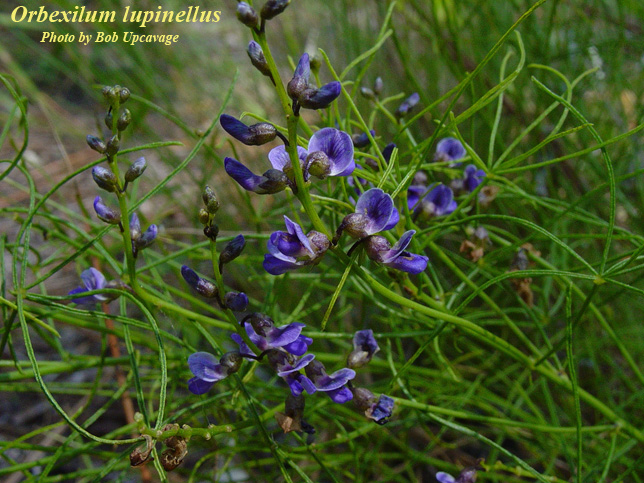Orbexilum lupinellus
| Orbexilum lupinellus | |
|---|---|

| |
| Photo by Bob Upcavage, Atlas of Florida Vascular Plants | |
| Scientific classification | |
| Kingdom: | Plantae |
| Division: | Magnoliophyta - Flowering plants |
| Class: | Magnoliopsida – Dicotyledons |
| Order: | Fabales |
| Family: | Fabaceae ⁄ Leguminosae |
| Genus: | Orbexilum |
| Species: | O. lupinellus |
| Binomial name | |
| Orbexilum lupinellus (Michx.) Isely | |

| |
| Natural range of Orbexilum lupinellus from USDA NRCS Plants Database. | |
Common names: Piedmont leather-root; lupine scurfpea, lupine leatherroot[1]
Contents
Taxonomic notes
Synonyms: Orbexilum lupinellum (Michaux) Isley; Psoralea lupinellus Michaux; Rhytidomene lupinellus (Michaux) Rydberg[1]
Varieties: none[1]
Description
O. lupinellus is a perennial herb, native to southern North America and Mexico. Its corolla is blue, pink, or violet and the leaves are palmately 5-7 foliate. The leaflets are linear to narrowly oblanceolate. They're 2-7 cm long and 0.5-2.0 (-3.5) mm wide; normally over 10x long as wide.[1]
Distribution
This species is endemic to the southeastern Coastal Plain, ranging from southcentral and southeastern North Carolina to central peninsular Florida, southern Alabama, and eastern Georgia.[1]
Ecology
Habitat
Habitats of O. lupinellus are sandhills, sandy pine-oak woods, scrub oak ridges, longleaf pine forests, slopes and upland oak-pine woods.[2] It has been observed to grow on loamy sand soils.[2] In a study comparing N2 fixation potential in nine legume species occurring in longleaf pine-wiregrass ecosystems, O. lupinellus had the lowest potential for N2 fixation.[3] Associated species include Pinus palustris, Quercus laevis, Q. incana, Q. stellata, and Aristida stricta.[2] Is also seen in human-disturbed areas such as clearing of pinewoods and disked areas.[2]
Phenology
O. lupinellus is a perennial herb[3] that flowers from May through July[4] and fruits from July through August.[1]
Seed dispersal
This species is thought to be dispersed by gravity.[5]
Fire ecology
O. lupinellus has been observed to grow in recently-burned longleaf pine forests.[2] Populations have been known to persist through repeated annual burning.[6]
Conservation, cultivation, and restoration
Cultural use
Photo Gallery
References and notes
- ↑ 1.0 1.1 1.2 1.3 1.4 1.5 Weakley, A.S. 2020. Flora of the Southeastern United States. Edition of 20 October 2020. University of North Carolina at Chapel Hill, Chapel Hill, North Carolina.
- ↑ 2.0 2.1 2.2 2.3 2.4 Florida State University Robert K. Godfrey Herbarium database. URL: http://herbarium.bio.fsu.edu. Last accessed: March 2016. Collectors: Collectors: William B. Fox, Robert K. Godfrey, H. E. Ahles, J. Haesloop, R. Kral, Wayne R. Faircloth, Steve L. Orzell, E. L. Bridges, Loran C. Anderson, Sidney McDaniel, D. J. Ockendon, O. Lakela, A.H. Curtiss, and Mr. and Mrs. R.H.A. Davis, R.A. Norris. States and Counties: Florida: Clay, Duval, Hamilton, Hillsborough, Leon, Madison, Suwannee, Taylor, Walton. Alabama: Autauga. Georgia: Baker, Lowndes, Thomas. North Carolina: Moore, Scotland.
- ↑ 3.0 3.1 Cathey, S. E., L. R. Boring, et al. (2010). "Assessment of N2 fixation capability of native legumes from the longleaf pine-wiregrass ecosystem." Environmental and Experimental Botany 67: 444-450.
- ↑ Nelson, G. PanFlora: Plant data for the eastern United States with emphasis on the Southeastern Coastal Plains, Florida, and the Florida Panhandle. www.gilnelson.com/PanFlora/ Accessed: 19 MAY 2021
- ↑ Kirkman, L. Katherine. Unpublished database of seed dispersal mode of plants found in Coastal Plain longleaf pine-grasslands of the Jones Ecological Research Center, Georgia.
- ↑ Platt, W.J., R. Carter, G. Nelson, W. Baker, S. Hermann, J. Kane, L. Anderson, M. Smith, K. Robertson. 2021. Unpublished species list of Wade Tract old-growth longleaf pine savanna, Thomasville, Georgia.